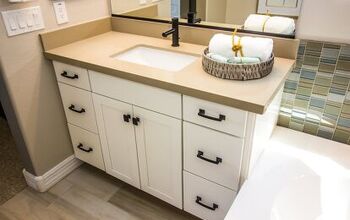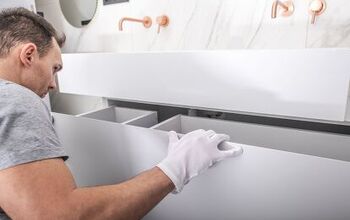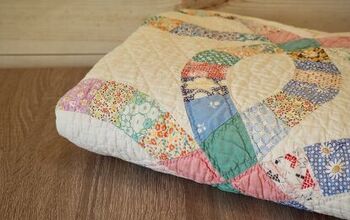Why Are Bathroom Vanities So Expensive? (Find Out Now!)

Whether you’re building a new house or remodeling an old one, your bathrooms are some of the most essential rooms in your home. Having a lovely bathroom vanity is crucial to getting the most enjoyment from your home. It’s also necessary to have a beautiful vanity if you ever hope to sell your house.
Bathroom vanities are expensive because of the material they’re made of and the labor involved with building them. A quality bathroom vanity takes time and finesse to build, and they’re often made out of sturdy and expensive material.
Vanities are often the cornerstone and centerpiece of your bathroom. Most individuals want them to look a certain way and set the tone for the mood of the bathroom. This article will look more at why bathroom vanities are so expensive. We’ll also look at how to save money on your vanity if the price is a problem.
Do You Need to Hire Cabinet Installers?
Get free, zero-commitment quotes from pro contractors near you.

Why are Bathroom Vanities so Expensive?
Bathroom vanities are expensive for several different reasons. They serve the dual purpose of being practical but also of being decorative. You want a sturdy and spacious vanity capable of holding things like toiletries and tissue paper. However, you also want a vanity that’s aesthetically pleasing because it’s likely the first thing people see when they enter your bathroom.
Let’s take a more in-depth look at why bathroom vanities are so expensive.
The Material They’re Made of
Bathroom vanities are often subjected to moisture, humidity, and rough treatment. They need to be made of durable and water-repellent material for these reasons. Finding wood or imitation wood and stain or paint with these features is difficult and expensive.
Particle-board, fiberboard, chipboard, plywood, and natural wood are a few of the options you have when it comes to bathroom vanity construction. Natural wood and plywood are two more expensive options, but they’re also durable and beautiful. Particleboard, fiberboard, and other imitation wood are cheaper, but it’s also more prone to water damage.
The Different Components of a Bathroom Vanity
People often forget that there’s more to a bathroom vanity than just the cabinet portion. There’s a countertop, cabinet doors, shelves, and drawers. Each of these components costs money, and the price can increase or decrease depending on how fancy and durable you want them to be. The doors, shelves, and drawers are often included with the vanity. The countertops, however, are usually not included and are sometimes as expensive as the vanity itself.
It also depends on how big of a vanity you choose to install. The size of the vanity is usually determined by the size of the bathroom and the number of people using it. For a Jack and Jill shared bathroom, people often install a vanity with a double sink. These vanities are larger and more expensive than other vanities, but it’s cheaper than installing two separate ones.
The Time It Takes to Make One
You have two options when it comes to bathroom vanities: pre-fabricated or custom-made. A custom-made vanity will be quite a bit more expensive than pre-fabricated ones. This is because custom vanities take longer to make and aren’t mass-produced like pre-fabricated vanities.
Custom vanities also often include unique shelving, drawers, doors, knobs, and countertops. Each of these items will cost extra than simply purchasing a pre-fabricated vanity at a home improvement store. The more labor that goes into your bathroom vanity, the more expensive it will be.
What Can I Expect to Pay for a Bathroom Vanity?
There is a wide range of price tags for bathroom vanities. You can spend anywhere from $100 to $3,000 or $4,000 for a bathroom vanity. A custom-made vanity constructed of natural wood and a granite or quartz countertop can cost $3,000 or $4,000 or even more. A pre-fabricated particleboard vanity with a countertop made of laminate or cheap wood can cost as little as $100 to $150.
It’s important to remember that you get what you pay for with a bathroom vanity. The more you spend on custom, quality materials, the more beautiful and durable your vanity will be. The cheaper your vanity is, the more likely it is to be made of poor materials, damaging easily and giving out quickly.
Don’t Forget About Installation Costs.
Another high cost to remember with your bathroom vanity is the cost of installation. Bathroom vanities and their countertops usually aren’t made by the same person that will install them. Carpenters and woodworkers usually make the vanities, but plumbers or construction workers usually install them.
Having your vanity professionally installed will cost anywhere between $300 and $1,000. This price covers the cost of labor and materials needed to install the vanity.
Can I Save Money on My Bathroom Vanity?
Luckily, if you’re on a tight budget, there are ways to save on your bathroom vanity. Here are some of those ways.
Purchase a pre-fabricated vanity
A pre-fabricated bathroom vanity can save you money without being cheaply made. Depending on what your budget is, there are pre-made vanities built out of real wood with quality countertops. Just because it’s pre-fabricated doesn’t mean that it has to be cheaply made. There are different types of pre-fabricated bathroom vanities to fit any price range.
Pre-fabricated bathroom vanities can cost anywhere from $100 to $2,000. If you’re desperate for savings, then you can opt for the super cheap option. If, however, you have a little more money to spend but don’t want to go the length of custom-designing your own vanity, you can spend a little more on a pre-made one.
Install the vanity yourself
Installing a bathroom vanity yourself might save you money, but it’s a lot of work. You’ll need to have construction experience, plumbing experience, and remodeling experience. The cost of installation will cost you anywhere between $200 up to $1,000. This price depends on what your plumber charges per hour and how long the job takes. The more complicated the installation, the longer it will take.
Opt for a cheaper countertop
Because the countertop is one of the most expensive components of your bathroom vanity, you can always choose a cheaper one. Quartz, granite, and marble are more costly materials for countertops. They’re also the most beautiful and longest-lasting options available.
Laminate and imitation wood are cheaper options, but they’re also less durable and more prone to nicks and cracks. Just as with the vanity itself, you get what you pay for with countertops.
Repurpose your old vanities
Another option is to repurpose your existing vanities or to purchase used ones. My wife and I remodeled our bathroom and did it on a tight budget. Rather than buying a new vanity and countertop, we replaced the doors and knobs on our old one. We then repainted everything to the color we wanted and installed a new countertop/sink combo. We did all the work ourselves, and our total cost was less than $150.
Going this route is more work and more time-consuming, but it’s also much cheaper.
Different Places to Purchase Bathroom Vanities
Depending on the style and price of the bathroom vanity you’re looking for, there are a number of different places you can buy them.
Cheap Vanity Stores
- Hardware stores like Lowes, Home Depot, and Menards.
- Online stores like Wayfare, Wal-Mart, and Amazon.
Expensive Vanity Shops
- More expensive furniture stores like Ashley Furniture, West Elm, and The Bath Outlet.
- Custom cabinet and countertop woodworkers. The odds are that there is at least one option available in your area.
How to Choose the Right Bathroom Vanity
Choosing the right bathroom vanity for you completely depends on your budget and your desires. If you want a new, clean bathroom vanity that “gets the job done,” there are tons of options available to you. If you have a larger budget and are looking to spend some money, there are also a ton of choices available to you. Here are some factors to take into consideration.
- How often is the vanity going to be used? Is it just for you, or is it for an entire family? The more people that use your vanity, the more likely it is to sustain damage and should be made of a sturdier material.
- What age are the people who are going to use it? Kids are more prone to damaging furniture than adults are.
- What’s your budget? The more money you have to spend, the better and more durable your vanity will be.
- Do you have plumbing and construction experience? If so, there’s a good chance that you can repurpose your old vanities or save money by installing new ones.
Related Questions
Can I use a kitchen cabinet for a bathroom vanity?
Depending on the size and style of the kitchen cabinet in question, there’s a chance that you can use it for a bathroom vanity.
How long does it take to install a bathroom vanity?
Installing a bathroom vanity takes anywhere from 2 hours to 10 hours, depending on the size and difficulty of the job. Larger vanities with custom countertops, sinks, and fixtures take longer to install than pre-fabricated ones. It also depends on the experience level of the person installing the vanity. A skilled plumber can install one in several hours, whereas if you do it yourself, it could take a day or two.
What is the most popular color for a bathroom vanity?
Bathroom vanities come in all shapes, sizes, and colors. The color you choose depends on the color of the rest of the bathroom and what your preference is. Overall, however, the most popular vanity colors are neutral ones like ebony, white, and gray.
Do You Need to Hire Cabinet Installers?
Get free, zero-commitment quotes from pro contractors near you.

Final Thoughts
Whether you choose to install your own bathroom vanity or have one custom-made and installed for you, vanities are expensive. While there are definitely ways to save money, bathroom vanities aren’t somewhere that you want to skimp on quality. Your bathroom vanity will be subjected to large amounts of moisture, steam, and humidity, and you’ll want a strong and durable one.

Before I started writing, I worked for 6 plus years in the plumbing, electrical, and HVAC business. I was primarily an HVAC installer but also worked as a plumber and electrician. Now I'm a copywriter, focusing on home improvement content and guides.
More by Jalin Coblentz

















![Standard Dining Room Table Dimensions [for 4, 6, 8, 10 and 12 People]](https://cdn-fastly.upgradedhome.com/media/2023/07/31/9074335/standard-dining-room-table-dimensions-for-4-6-8-10-and-12-people.jpg?size=350x220)









